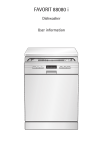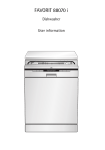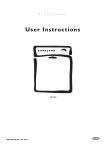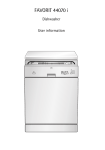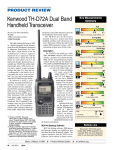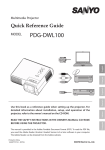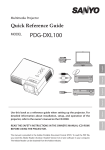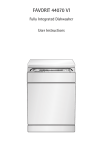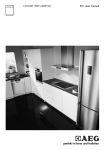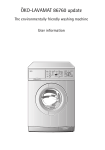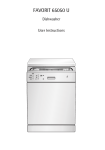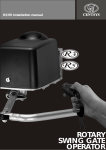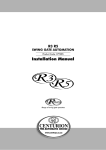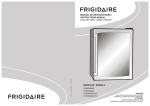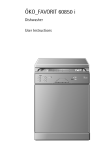Download Electrolux U04306 User's Manual
Transcript
D i s h w a s h e r User Instructions ESF 631 ANC 822 945 701 - 00 - 0600 EN Dear customer, Please read these user instructions carefully. Above all please observe the safety instructions on the first few pages ofthese user instructions! Please keep these user instructions for later reference. Pass them on to any subsequent owner of the appliance. 1 The warning triangle and/or specific words (Warning!, Caution!, Important!) are used to highlight instructions that are important for your safety or for the function of the appliance. It is imperative that these instructions are observed. This symbol or numbered instruction steps lead you step for step through the operation of the appliance. 3 Next to this symbol you receive additional information and practical tips on using the appliance. 2 Tips and instructions for the economical and environmentally conscious use of the appliance are marked with a clover leaf. In the event of a malfunction, these operating instructions contain information on how to rectify faults yourself, see the "What to do, if..." section. If these instructions are insufficient, please contact your nearest customer service centre. In the case of technical problems, our customer service organisation is available to provide you with assistance at any time (you will find addresses and telephone numbers in the "Customer Service Centres" section). In this respect please read the "Service" note on the rear of these user instructions. 2 Contents Safety Instructions . . . . . . . . . . . . . . . . . . . . . . . . . . . . . . . . . . . . . . . . . . . . . . . . . . . . . . . . . . . . . . . . . . . . . . 4 Securing the door of the dishwasher . . . . . . . . . . . . . . . . . . . . . . . . . . . . . . . . . . . . . . . . . . . . . . . . . . . . . . . . . 5 Disposal . . . . . . . . . . . . . . . . . . . . . . . . . . . . . . . . . . . . . . . . . . . . . . . . . . . . . . . . . . . . . . . . . . . . . . . . . . . . . . 5 Economical and Ecological Dishwashing . . . . . . . . . . . . . . . . . . . . . . . . . . . . . . . . . . . . . . . . . . . . . . . . . . . 6 Appliance Features and Control Panel . . . . . . . . . . . . . . . . . . . . . . . . . . . . . . . . . . . . . . . . . . . . . . . . . . . . . 7 Control panel . . . . . . . . . . . . . . . . . . . . . . . . . . . . . . . . . . . . . . . . . . . . . . . . . . . . . . . . . . . . . . . . . . . . . . . . . . . 8 Prior to using for the first time . . . . . . . . . . . . . . . . . . . . . . . . . . . . . . . . . . . . . . . . . . . . . . . . . . . . . . . . . . . . 9 Adjusting the Water Softener . . . . . . . . . . . . . . . . . . . . . . . . . . . . . . . . . . . . . . . . . . . . . . . . . . . . . . . . . . . . . . . 9 Filling with Special Salt for the Water Softener . . . . . . . . . . . . . . . . . . . . . . . . . . . . . . . . . . . . . . . . . . . . . . . . 10 Filling with Rinse Aid . . . . . . . . . . . . . . . . . . . . . . . . . . . . . . . . . . . . . . . . . . . . . . . . . . . . . . . . . . . . . . . . . . . . 11 Adjusting Rinse Aid Dosing . . . . . . . . . . . . . . . . . . . . . . . . . . . . . . . . . . . . . . . . . . . . . . . . . . . . . . . . . . . . . 11 In Daily Use . . . . . . . . . . . . . . . . . . . . . . . . . . . . . . . . . . . . . . . . . . . . . . . . . . . . . . . . . . . . . . . . . . . . . . . . . . . 12 Loading cutlery and dishes . . . . . . . . . . . . . . . . . . . . . . . . . . . . . . . . . . . . . . . . . . . . . . . . . . . . . . . . . . . . . . . 12 Loading Cutlery . . . . . . . . . . . . . . . . . . . . . . . . . . . . . . . . . . . . . . . . . . . . . . . . . . . . . . . . . . . . . . . . . . . . . . 13 Loading Pans, Frying Pans and Large Plates . . . . . . . . . . . . . . . . . . . . . . . . . . . . . . . . . . . . . . . . . . . . . . . 13 Loading Cups, Glasses and Coffee Services . . . . . . . . . . . . . . . . . . . . . . . . . . . . . . . . . . . . . . . . . . . . . . . 14 Filling with Detergent . . . . . . . . . . . . . . . . . . . . . . . . . . . . . . . . . . . . . . . . . . . . . . . . . . . . . . . . . . . . . . . . . . . . 15 Selecting the Wash Programme (Programme Table) . . . . . . . . . . . . . . . . . . . . . . . . . . . . . . . . . . . . . . . . . . . 16 Starting the Wash Programme . . . . . . . . . . . . . . . . . . . . . . . . . . . . . . . . . . . . . . . . . . . . . . . . . . . . . . . . . . . . . 17 Changing/Interrupting the Wash Programme . . . . . . . . . . . . . . . . . . . . . . . . . . . . . . . . . . . . . . . . . . . . . . . 17 Switching Off the Dishwasher . . . . . . . . . . . . . . . . . . . . . . . . . . . . . . . . . . . . . . . . . . . . . . . . . . . . . . . . . . . . . 18 Care and Cleaning . . . . . . . . . . . . . . . . . . . . . . . . . . . . . . . . . . . . . . . . . . . . . . . . . . . . . . . . . . . . . . . . . . . . . 19 Cleaning the Filter . . . . . . . . . . . . . . . . . . . . . . . . . . . . . . . . . . . . . . . . . . . . . . . . . . . . . . . . . . . . . . . . . . . . . . 19 What to do, when ... . . . . . . . . . . . . . . . . . . . . . . . . . . . . . . . . . . . . . . . . . . . . . . . . . . . . . . . . . . . . . . . . . . . . 20 ...there are problems with the operation of the dishwasher. . . . . . . . . . . . . . . . . . . . . . . . . . . . . . . . . . . . . . . 20 ...the wash result is unsatisfactory. . . . . . . . . . . . . . . . . . . . . . . . . . . . . . . . . . . . . . . . . . . . . . . . . . . . . . . . . . 20 Technical Data . . . . . . . . . . . . . . . . . . . . . . . . . . . . . . . . . . . . . . . . . . . . . . . . . . . . . . . . . . . . . . . . . . . . . . . . 21 Notes for Test Institutes . . . . . . . . . . . . . . . . . . . . . . . . . . . . . . . . . . . . . . . . . . . . . . . . . . . . . . . . . . . . . . . . 22 Installation and Connection Instructions . . . . . . . . . . . . . . . . . . . . . . . . . . . . . . . . . . . . . . . . . . . . . . . . . . . 24 Installing the Dishwasher . . . . . . . . . . . . . . . . . . . . . . . . . . . . . . . . . . . . . . . . . . . . . . . . . . . . . . . . . . . . . . . 24 Dishwashers That Can Be Integrated . . . . . . . . . . . . . . . . . . . . . . . . . . . . . . . . . . . . . . . . . . . . . . . . . . . . . 25 Built-In Dishwasher . . . . . . . . . . . . . . . . . . . . . . . . . . . . . . . . . . . . . . . . . . . . . . . . . . . . . . . . . . . . . . . . . . . 25 Free-Standing Appliances . . . . . . . . . . . . . . . . . . . . . . . . . . . . . . . . . . . . . . . . . . . . . . . . . . . . . . . . . . . . . . 25 Connecting the Dishwasher . . . . . . . . . . . . . . . . . . . . . . . . . . . . . . . . . . . . . . . . . . . . . . . . . . . . . . . . . . . . . 27 Water connection . . . . . . . . . . . . . . . . . . . . . . . . . . . . . . . . . . . . . . . . . . . . . . . . . . . . . . . . . . . . . . . . . . . . . . . 27 Permitted water pressure . . . . . . . . . . . . . . . . . . . . . . . . . . . . . . . . . . . . . . . . . . . . . . . . . . . . . . . . . . . . . . 27 Connect the inlet hose . . . . . . . . . . . . . . . . . . . . . . . . . . . . . . . . . . . . . . . . . . . . . . . . . . . . . . . . . . . . . . . . 27 Water drain . . . . . . . . . . . . . . . . . . . . . . . . . . . . . . . . . . . . . . . . . . . . . . . . . . . . . . . . . . . . . . . . . . . . . . . . . 28 Leak Prevention System . . . . . . . . . . . . . . . . . . . . . . . . . . . . . . . . . . . . . . . . . . . . . . . . . . . . . . . . . . . . . . . 28 Electrical connection . . . . . . . . . . . . . . . . . . . . . . . . . . . . . . . . . . . . . . . . . . . . . . . . . . . . . . . . . . . . . . . . . . . . 29 Connections . . . . . . . . . . . . . . . . . . . . . . . . . . . . . . . . . . . . . . . . . . . . . . . . . . . . . . . . . . . . . . . . . . . . . . . . . . . 30 Service . . . . . . . . . . . . . . . . . . . . . . . . . . . . . . . . . . . . . . . . . . . . . . . . . . . . . . . . . . . . . . . . . . . . . . . . . . . . . . . 31 3 1 Safety Instructions The safety aspects of ELECTROLUX electrical appliances comply with accepted technical standards and the German Appliance Safety Law. Nevertheless, as a manufacturer we consider it our obligation to make you aware of the following safety information: Installation, Connection and Placing into Operation • • • • The dishwasher may only be transported upright. Check the dishwasher for transport damage. Do not in any circumstances connect an appliance that is damaged. In the case of damage, please contact your supplier. Prior to placing the appliance in operation, ensure that the nominal voltage and type of supply on the rating plate match that of the supply where the appliance is to be installed. The fuse rating is also to be found on the rating plate. For information on how to correctly install and connect up your dishwasher, please read the “Installation“ section. Multiway plugs / connectors and extension cables must not be used. This could constitute a safety hazard. • • • • • • Correct Use • Child Safety • • • • • Children often do not recognise the hazards associated with the use of electrical appliances. It is therefore important that you ensure children are adequately supervised and that you do not allow children to play with the dishwasher – there is a risk that children can shut themselves inside the appliance (risk of suffocation!). Packaging materials (e.g. films, styrofoam) can be dangerous for children. Risk of suffocation! Keep packaging away from children. Detergents can cause burns to the eyes, mouth, and throat, or even cause choking! Please observe the manufacturer's safety instructions for cleaners and detergents. The water in your dishwasher is not suitable for drinking. If there are still remnants of detergent in the appliance, there is a risk of burns! When disposing of the dishwasher: unplug from the mains, cut off and dispose of the mains cable. Break the door lock so that the door no longer shuts. General Safety • 4 Repairs to the dishwasher are only to be carried out by qualified service engineers. Improper repairs can give rise to significant hazards for the user. If your appliance needs repairing, please contact customer service or your dealer. Never place the dishwasher in operation if the mains cable, water inlet or drain hose is damaged; or the control panel, work top or plinth area is damaged such that the inside of the appliance is freely accessible. If the mains lead is damaged, or is to be replaced for a longer lead, the cable (obtainable from ELECTROLUX customer service) must be changed by a service engineer authorised by ELECTROLUX. Never unplug the appliance by pulling on the cable, always pull the plug. Additions or modifications to the dishwasher are not permitted for safety reasons. Ensure that the door of the dishwasher is always closed when it is not being loaded or unloaded. In this way you will avoid anybody tripping over the open door and hurting themselves. Sharp knives and items of cutlery with sharp edges must be placed in the cutlery tray or in the upper rack. • • • • • Only wash household dishes using the dishwasher. If the appliance is used for other purposes, or is used incorrectly, the manufacturer cannot accept any liability for any damage caused. Prior to use, ensure that the manufacturers of the special salt, detergent, and rinse aid employed specifically permit the usage of their products in household dishwashers. Do not put any solvents in the dishwasher. There is a risk of an explosion! The anti-flood system provides dependable protection against damage due to leaks. For this system to function correctly, the following preconditions must be met: – The appliance must remain connected to the mains even when it is switched off. – The dishwasher must be correctly installed. – Always shut off the water supply at the tap when the dishwasher is not to be used for longer periods, e.g. when you are away on holiday. Do not sit or stand on the open door, the appliance may tip over. In the event of a fault, first close the tap, then switch off the appliance and unplug it from the mains. If the appliance is permanently wired to the mains: switch off the fuse(s) or unscrew them. Securing the door of the dishwasher This way you can ensure that children cannot open the door of the dishwasher: 1. There is a lever (1) on the left side of the door handle. You can secure the door against being opened unintentionally by pressing this lever to the back using a small screwdriver or the handle of a spoon. 2. Once the lever has been pushed back, you must first push the door handle to the left (2) and then push it upwards (3) in order to open the door. 3. You can remove the safety lock from the door again by pulling the lever forwards again using a small screwdriver or the handle of a spoon. 2 Disposal Disposing of the Packaging Material Dispose of the dishwasher packaging material correctly. All the packaging materials used are harmless to the environment and can be recycled. • Plastic parts are marked with standard international abbreviations: – >PE< for polyethylene, e.g. sheet wrapping material – >PS< for polystyrene, e.g. padding material (always CFC-free) – >POM< for polyoxymethylene, e.g. plastic clips • Cardboard packaging is manufactured from recycled paper and should be deposited in the waste paper collection for recycling. Disposal of old appliances As and when you cease to use your dishwasher, please take it to a recycling centre or to your dealer who will, for a small contribution to the costs, dispose of it for you. 5 2 Economical and Ecological Dishwashing • • • • • 6 Only connect the dishwasher to the hot water supply if your hot water is not electrically heated. Ensure that the water softener is correctly adjusted. Do not pre-rinse dishes under running water. Select the wash programme to suit the nature and degree of the soiling on the dishes. Do not use more detergent, special salt or rinse aid than is recommended in these operating instructions and by the manufacturer of the respective product. Appliance Features and Control Panel Rubber Seal for Connecting the Water Feed to the Upper Spray Arm Spray Arms Water Hardness Switch Container for Special Salt Container for Rinse Aid Container for Detergent Rating Plate Filters 7 Control panel Programme Selector Door Handle Switch on the dishwasher and start a wash programme using the programme selector. 8 Programme Switch Set the point at which the wash programme is to start using the programme switch. The programme switch rotates during the wash programme and indicates the position that has been reached in the programme. Prior to using for the first time Prior to using for the first time, remove all the clips with which the dish racks are secured for transport. Then perform the following steps: 1. Adjust the water softener 2. Filling with Special Salt for the Water Softener 3. Filling with Rinse Aid Adjusting the Water Softener To prevent the build up of scale on dishes and in the dishwasher, the dishes must be washed with soft, i.e. low lime content water. For this reason the dishwasher is fitted with a water softener in which tap water from a hardness of 4 °d (German degrees) is softened with the aid of special salt. 3 Your local water authority can advise you on the hardness of the water in your area. The water softener has 4 settings. Water Hardness Turn the arrow on the water in °d1) in ppm2) hardness switch to number 29-50 22-28 510 - 900 390 - 500 4 3 15-21 260 - 380 2* 4-14 70 - 250 1 under 4 under 70 1 no salt necessary 1)(°d) German degree, measure of water hardness 2)(ppm) parts per million (CaCO3) *Factory setting Adjust the water softener in accordance with the table to suit your area: 1. Open the door on the dishwasher. 2. Remove the lower rack from the dishwasher. 3. Adjust the water hardness switch with, e.g. a coin. 4. Replace the lower rack and close the door of the dishwasher. 9 Filling with Special Salt for the Water Softener 1 Use only special salt for dishwashers. Never fill the salt container with any another type of salt (e.g. culinary salt) or dishwasher detergent. This would irreparably damage the water softener. Prior to filling with salt, please check each time that you really do have a packet of special salt in your hand. Fill with special salt: • • Prior to using the dishwasher for the first time If a green mark can be seen under the lid of the special salt container, then there is sufficient special salt. If the green mark cannot be seen, you must refill the container with special salt. 3 If the water hardness in your area is less than 4 °d, you do not need to use special salt. The green mark will then not be visible. The function of the appliance is not impaired. 1. Open the door, remove the lower rack. 2. Undo the lid on the salt container by turning it anticlockwise. 3. Only when using for the first time: fill the salt container with water. 4. Place the funnel supplied on the container opening. Fill the container with special salt through the funnel; the capacity of the container is approx. 1.01.5 kg depending on the grain size. Do not overfill the salt container with special salt. The water expelled by filling the salt container with special salt runs out of the salt container onto the base of the washing compartment. This is not a cause for concern, the water will be pumped out at the start of the next wash programme. 5. Clean any salt remnants on the container opening. 6. Turn the lid clockwise to the stop, otherwise special salt will leak into the wash water. Dull glasses may result. 7. If you are not going to wash your dishes immediately, you should run the Pre Wash programme 3 b. This will wash away salt water that has run out of the container and any grains of salt that have been spilt. 3 10 Depending on the size of the salt grains, it can take several hours for the salt to dissolve in the water and the green mark to become visible again. The setting of the water softener and thus the consumption of salt are dependent on the hardness of the local water. LE SA ALT Z S AL S EL S Filling with Rinse Aid Rinse aid ensures that your dishes gleam and are free from spots, and that you glasses are clear. 1 Use only branded rinse aid for dishwashers. Never fill the rinse aid container with any another substance (e.g. concentrated vinegar). This would damage the appliance. Fill with rinse aid: • • Prior to using the dishwasher for the first time. When a dark point surrounded by a light ring is to be seen in the indicator window on the container. If there is sufficient rinse aid in the container, the indicator window is uniformly dark. The rinse aid container is on the inside of the dishwasher door. 1. Open the door . 2. Turn the lid of the container ¼ of a turn anticlockwise and remove. ax 6 5 4 1 32 m 3. Fill with rinse aid, up to the broken line as a maximum; this line corresponds to a quantity of approx. 150 ml . 4. Replace the lid and tighten by turning clockwise. 5. If rinse aid has been spilt, wipe up with a cloth. Otherwise there will be too much foam during washing. Adjusting Rinse Aid Dosing Rinse aid is added to the wash water from the container when the dishes are rinsed. The dose can be adjusted from 1-6, corresponding to 1-6 cm3 rinse aid. The dose is set to "4" in the factory. Only change the dose when streaks, milky spots or dried water drops are to be seen on glasses and dishes. (see under "What to do, if..."). Turn the lid of the container ¼ of a turn anticlockwise and remove. Adjust the dose setting with a tea spoon. Replace the lid and tighten by turning clockwise. If rinse aid has run out, wipe up with a cloth. 3 1. 2. 3. 4. 11 In Daily Use • • • • • Is it necessary to refill with special salt or rinse aid? Load cutlery and dishes into the dishwasher Fill with dishwasher detergent Select a wash programme suitable for the cutlery and dishes Start the wash programme Loading cutlery and dishes 1 Sponges, household cloths and any object that can absorb water may not be washed in the dishwasher. For washing in the dishwasher the following cutlery/dishes are not suitable: – Cutlery with wooden, horn, china or mother of pearl handles – Plastic items that are not heat resistant – Older cutlery with cement that is not temperature resistant – Bonded cutlery items or dishes – Pewter or copper items – Lead crystal glass – Steel items subject to rusting – Wooden platters – Items made from synthetic fibres • • 12 Before loading the dishes, you should: – Remove large left-overs. – Soften remnants of burnt food in pans. When loading the dishes and cutlery, please note: – Dishes and cutlery must not impede the rotation of the spray arms. – Load hollow items such as cups, glasses, pans, etc. with the opening downwards so that water cannot collect in the container or a deep base. – Dishes and items of cutlery must not lie inside one another, or cover each other – To avoid damage to glasses, they must not touch – Do not lay small objects (e.g. lids) in the cutlery rack are of limited suitability: – Only wash stoneware in the dishwasher if it is specifically marked as being dishwasher-safe by the manufacturer. – Glazed patterns may fade if machine washed frequently. – Silver and aluminium parts have a tendency to discolour during washing. Left-overs, e.g. egg white, egg yolk and mustard often cause discolouring and staining on silver. Therefore always clean left-overs from silver immediately, if it is not to be washed straight after use. – Some types of glass can become dull after a large number of washes. Loading Cutlery 1 Long bladed knives stored in an upright position are a potential hazard. 1 Long and/or sharp items of cutlery such as carving knives must be positioned horizontally in the upper basket. 1 Take care when loading or unloading sharp items such as knives. To ensure that all items of cutlery are completely washed, you should 1. Place the grid insert on the cutlery rack 2. Place short knives, forks and spoons in the grid insert with their handles pointing downwards. Some models of dishwasher have cutlery baskets without a cutlery grid. Loading Pans, Frying Pans and Large Plates Load large and heavily soiled dishes in the lower rack. 3 To make it easier to load large dishes, it is possible - to remove the plate inserts from the lower rack. - to move the cutlery basket sideways. 13 Loading Cups, Glasses and Coffee Services Load small, delicate items and long pointed cutlery in the upper rack. • Arrange plates and dishes offset on and under the folding cup racks so that washing water can reach all items. • The cup racks can be folded up out of the way for tall items. • Lay or hang wine, champagne, and brandy glasses in the cut outs on the cup racks. • Glasses, beakers, etc. can also be placed on the two rows of prongs on the left of the upper rack. 14 Filling with Detergent 1 Use only dishwasher detergent. Fill with Detergent: Prior to the start of a wash programme (not for the Pre Wash programme). The detergent is released into the wash water during the programme. 2 Please observe the manufacturer’s dosing and storage recommendations given on the detergent packaging. The detergent dispenser is on the inside of the door. 1. If the lid is closed: Press the latching lever (1) forwards. The lid springs open. 2 1 2. Fill the detergent dispenser with detergent. The markings are an aid to correct dosing: "MIN" corresponds to approx. 30 ml detergent, "MAX" corresponds to approx. 40 ml detergent. 3. Close the lid, press it down until the latch engages. 3 In the case of heavily soiled dishes, add additional detergent in the cavity in the lid (2). This detergent is effective during the pre wash. X: MA N: MI 15 Selecting the Wash Programme (Programme Table) Choose the most suitable wash programme with the aid of this table: Type of Dishes: Dinner Service and Cooking Utensils In Addition: Type of Soiling: normally soiled dried left-overs Suitable Programme: Coffee Service and Dessert Dishes All Dish Types with non-temperature resistant dishes normally soiled normally to lightly soiled particularly suited to the use of concentrated detergents. Used dishes that are collected in the dishwasher and are to be washed at a later point in time. NORMAL 65 °C 2) NORMAL 50 °C ECO 50 °C PRE WASH B B C A Turn programme switch to: fq Turn programme selector to: or fq fo go fo or go Programme Sequence: Pre Wash Main Wash Intermediate Rinse Final Rinse Drying Consumption Figures: 1) Pre Wash Main Wash Intermediate Rinse Final Rinse Drying Main Wash Intermediate Rinse Final Rinse Drying Pre Wash - Duration: 90 minutes 86 minutes 75 minutes 10 minutes Energy: 1,45 kWh 1,4 kWh 1,2 kWh < 0.1 kWh Water: 18 litres 18 litres 14 litres 6 litres 16 1) The consumption figures were recorded under standard conditions. They are dependent on the loading of the dish racks. Variations are therefore possible in practice. 2) Test programme Starting the Wash Programme 1. Check that the dishes and cutlery are loaded into the dishwasher in such a manner that the spray arms are free to rotate. 2. Open the tap fully. 3. Close dishwasher door. 4. Turn the programme switch clockwise to A, or B or C (see „ Programme Table“). For interference suppression reasons, only operate the programme switch with the dishwasher switched off. It is also possible that the automated addition of detergent will be triggered. 5. Turn the programme selector to the required programme (see „ Programme Table“). The selected wash programme starts. The programme switch rotates during the wash programme and indicates the position that has been reached in the programme. 1 1 Interrupting the wash programme by opening the door of the dishwasher Hot steam can escape when the door is opened. There is a risk of scolding! Open the door carefully. 1. Open the door of the dishwasher. The wash programme stops. 2. Shut the door. The wash programme continues. 1 If a wash programme has been started even though the tap was closed, turn the programme selector to the I position, open the tap and start the programme again. Changing/Interrupting the Wash Programme 3 Only change or interrupt a wash programme in progress if it is absolutely necessary. When the appliance is closed again, the air that has entered is heated rapidly and expands. This can cause water to escape onto the floor and possibly trigger the antiflood system. Changing the wash programme 1. Turn the program selector to the I position. Wash programme stops. Hot steam can escape when the door is opened. There is a risk of scolding! Open the door carefully. Open dishwasher door and check whether there is still detergent in the container. Refill the container if necessary. Close dishwasher door. Turn the programme switch clockwise to A, or B or C (see „ Programme Table“). Turn the programme selector to the required programme (see „Programme Table“). Wash programme starts. 1 2. 3. 4. 5. 17 Switching Off the Dishwasher When the wash programme is finished: 1. Turn the program selector to the I position. Hot steam may escape if the door is opened immediately after the end of the programme. Therefore: 2. Open the door carefully. 1 Emptying the Dishwasher Hot dishes are sensitive to knocks. The dishes should therefore be allowed to cool down before removing them from the appliance. The dishes will dry quicker if, when the programme has finished, you briefly open the door fully and then leave it slightly ajar. Leave the dishes in the dishwasher for approx. 15 minutes after the end of the programme so that they dry better and can cool down. Empty the lower rack first, then the upper rack. In this way you will avoid any water left on the upper rack dripping onto the dishes in the lower rack and causing water spots. 3 • • • 1 18 Please note, that if your dishwasher is installed under a kitchen worktop, escaping steam may damage the worktop. Its underside must be protectad against rising steam with aluminium foil as prescribed. Care and Cleaning Do not under any circumstances use furniture care products or aggressive cleaners. If necessary, clean the controls only with a soft cloth and pure warm water. The spray arms do not need cleaning. Occasionally check the internal containers, door seal, and water inlet for soiling, clean if necessary. 1 • • • Cleaning the Filter 3 The filters in the base of the washing compartment are to a large extent self-cleaning. Nevertheless the filters should be checked and cleaned from time to time. Dirty filters will degrade the washing result. 1. Open the door, remove the lower rack. 2. The dishwasher filter system comprises a coarse/ fine filter, microfilter and a flat filter. Unlock the filter system using the handle on the microfilter, and remove. 3. Turn the handle about ¼ a turn anticlockwise and remove. 4. Take hold of the coarse/fine filter (1) by the handle with the hole and remove from the microfilter (2). 5. Clean all filters thoroughly under running water. 6. Remove the flat filter (3) from the base of the washing compartment and clean both faces thoroughly. 7. Put the flat filter back in the base of the washing compartment. 8. Place the coarse/fine filter in the microfilter and press together. 9. Put the filter combination in place and lock by turning the handle clockwise to the stop. During this process ensure that the flat filter does not protrude .above the base of the washing compartment. 1 Under no circumstances may the dishwasher be used without filters. 19 What to do, when ... Try to rectify minor faults on the dishwasher with the aid of the instructions given here. If you call in customer service to resolve one of the malfunctions listed here, or rectify an error made in the operation of the appliance, the customer service engineer’s visit is not free of charge, even during the period of guarantee. ...there are problems with the operation of the dishwasher. Malfunction Possible Cause Remedy The drain pump in the dishwasher runs continThe anti-flood system has been triggered. uously - even with the appliance switched off. The programme does not start. The door of the dishwasher is not closed properly. Shut the door. Mains plug is not plugged in. Insert mains plug. House fuse in defective. Replace fuse. Where dishes are to be washed immediately, for appliances In the case of dishwasher models with start - with multidisplay, set the delay start delay timer: to 0. A start delay is selected. - without multidisplay, cancel the delay start timer. The washing compartment is made of corrosion-resistant stainless steel. Rust spots Rust spots are visible in in the washing compartment are from partithe washing compartcles from outside the appliance (rust partiment. cles from the water pipe, from pans, cutlery, etc.). Remove such spots with a commercially available stainless steel cleaner. There is a whistling noise during washing. Close the tap, then unplug from the mains and contact customer service. The whistling is not a cause for concern. Only wash cutlery and dishes that are suitable for dishwasher use. Close the lid of the special salt container securely. Use a different brand of detergent. ...the wash result is unsatisfactory. The dishes are still dirty. • • • • • 20 The wrong wash programme was selected. The dishes were arranged in such a manner that water has not reached all parts. The dish racks must not be overloaded. The filter in the base of the washing compartment is dirty or incorrectly positioned. Detergent was not used or too little was used. In the case of scale deposits on the dishes: the special salt container is empty or the water softener is incorrectly adjusted. • The drain hose is incorrectly laid. The dishes are wet and dull. • • Rinse aid was not used. The rinse aid container is empty. There are streaks, milky spots or a bluish coating on glasses and dishes. • There are dried water drops on the glasses and dishes. • • Increase rinse aid dosing. The detergent may be the cause. Contact the detergent manufacturer's consumer advisor. Decrease rinse aid dosing. Technical Data Capacity: 12 place settings including serving dishes Permitted Water Pressure: 1-10 bar (=10-100 N/cm2 = 0.1-1.0 MPa) Electrical Connection: Information on the electrical connection is given on the rating plate on the inner edge of the dishwasher door on the right. Dishwasher: Free-Standing Appliances Dimensions: 850 x 600 x 600 (H x B x D in mm) Max. Weight: 54 Kg Dishwashers that Can Be Integrated or Fully Integrated, Built-In Dishwashers That Can Be Fitted With Decor Panels Dimensions: 820 – 880 x 595 x 570 (H x B x D in mm) Max. Weight: 50 Kg appliance conforms with the following ; This EU Directives: • • 73/23/EWG dated 19. 02. 1973 – Low Voltage Directive 89/336/EWG dated 03. 05. 1989 (including Directive Amendment 92/31/ EWG) – EMC Directive 21 Notes for Test Institutes The salt container for the water softener and the rinse aid container must be completely full prior to the test. Test Standard: EN 50 242 Comparative Program: see "Program table: Test programme" for full and half load Full Load: 12 place settings incl. serving dishes Detergent Dosing: 30g (Type B) in the detergent container Half Load: 6 place settings including serving dishes Every second place is left empty in the case of a half load. Detergent Dosing: 20g (Type B) in the detergent container Rinse Aid Setting: 4 (Type III) for full and half load Example Loading Arrangements: Top rack Example Loading Arrangements: Top rack 22 Example Loading Arrangements: Bottom rack Example Loading Arrangements: Cutlery basket 23 INSTALLATION AND CONNECTION INSTRUCTIONS Installing the Dishwasher • • The dishwasher must be installed on a firm floor and adjusted to ensure that it is stable and level. To compensate for unevenness in the floor and to match the height of the appliance to that of surrounding units extend the threaded feet by unscrewing. Depending on the design of the threaded feet use either – an open-end spanner or – a screwdriver. • • • 24 For built-in, integrated and fully integrated dishwashers, the rear feet should be adjusted from the front of the appliance using a screwdriver. The drain hose, inlet hose and mains cable must not be kinked or crushed when the dishwasher is in position. The dishwasher must also be screwed on tightly to the work surface or to the adjoining units. This is essential to ensure the diswasher does not tip. Depending on type, the dishwasher is to be installed as follows: Dishwashers That Can Be Integrated (see installation template supplied) 3 The door of the appliance can be fitted with a wooden furniture door with the following dimensions Width: 591 – 594 mm Thickness: 16 – 24 mm Height: (variable) dependent on Weight: max. 8 kg 1 - Recess height - Plinth height - The adjustment so that the unit matches the height of the adjoining units The exact height of the adjoining units must be measured at the place of installation. If the facing panel is longer than 600 mm, the door of the appliance cannot be opened completely (the facing panel bumps against the plinth). If this is the case, the plinth must be cut out (see installation template) or the brace adapter for the extra long door BLT 60 must be used. You can obtain this with the E No. 911 239 008. Built-In Dishwasher (see enclosed installation instructions) Free-Standing Appliances 1 can be set up as stand-alone without additional installation. If the dishwasher is set up next to a cooker, a heat-insulating, non-flammable plate must be mounted between the dishwasher and the cooker, flush to the top edge of the work surface (depth 57.5 cm). The plate should have aluminium foil on the side facing the cooker. If the dishwasher is installed underneath a kitchen work surface, the original work surface of the dishwasher is to be removed as follows: 1. Unscrew the screws (1) from the elbows on the back side. 2. Slide the work surface approx. 1 cm to the rear (2), lift at the front (3) and remove. 3. Press the work surface retaining brackets at the position (4) shown in the diagram and remove the bracket at an angle to the rear (5). 4 5 25 1 If the dishwasher is later used as a freestanding appliance, the original work surface must be re-mounted. 3 The plinth on free-standing appliances is not adjustable. • • • • 26 Free-standing appliances can be fitted with a décor panel to match the facings of other kitchen equipment. The décor panels must be obtained from the kitchen manufacturer. A décor frame is necessary for installation, and can be obtained as an accessory from the dealer if not included in the scope of delivery. Decor panel dimensions: – Height 597mm – Width 587mm – Clamp thickness: max. 4mm The corners of the décor panels must be chamfered at 5 mm x 45°. To ensure that thin decor panels do not flex or distort, attach them to the door of the appliance using double sided adhesive tape. Connecting the Dishwasher Water connection The dishwasher is fitted with safety devices that prevent the return of wash water into the drinking water system and comply with the applicable plumbing regulations. • The dishwasher can be connected to cold and hot water supplies up to max. 60 °C. • The dishwasher must not be connected to open hot water appliances or instantaneous water heaters. Permitted water pressure Lowest permitted water pressure: 1 bar (=10N/cm2 =100 kPa) For a water pressure of less than 1 bar please seek advice from customer service. Highest permitted water pressure: 10 bar (=100 N/cm2 =1 MPa) In the case of a water pressure greater than 10 bar, a pressure reduction valve must be used (available from your dealer). Connect the inlet hose 1 The water inlet hose must not be kinked, crushed or entangled when it is being connected up. Connect the threaded hose fitting (DIN 259) on the water inlet hose to a tap with an external thread (¾ inch). Tighten the threaded hose fitting only by hand. 3 • In order that access to the tap in the kitchen is not limited by the use of the dishwasher, we recommend the installation of an additional tap, or the fitting a two way adapter to the existing tap. If you need a longer water inlet hose than that supplied, the following VDE approved complete hose sets are to be used, these are available from your dealer: – Hose set "WRflex 100" (E No.: 911 239 034) – Hose set "WRflex 200" (E No.: 911 239 035) 27 Water drain Drain hose The drain hose must not be kinked, crushed or entangled. Connecting the drain hose: – Maximum permitted height: 1 metre. – Minimum required height 30 cm above the lower edge of the machine. 1 • Extension hoses • • Extension hoses are available from your dealer or customer service. The internal diameter of the extension hoses must be 19 mm to ensure that the function of the appliance is not impeded. Extension hoses may be laid a maximum of 3 metres horizontally; the maximum permitted height for the connection for the drain hose is then 85 cm. Siphon connection • • The outlet of the drain hose (ø 19 mm) fits all commonly available siphon types. The outer diameter of the siphon connection must be at least 15 mm. The drain hose must be fixed to the siphon connection using the hose clamp supplied. Water drain into wash basins (only possible with free-standing appliances) In the case that you wish to hang the drain hose in a wash basin, use a detachable hose elbow. You can obtain this from customer service under spare part number ET 646 069 190. 1. Fit the elbow to the drain hose. 2. Secure the drain hose against sliding off the edge of the wash basin. Pass a piece of cord through the hose elbow and fix it to the wall or the tap. Leak Prevention System For protection from damage due to water leaks, the dishwasher is equipped with a leak prevention system. In the event of a fault, the drain pump switches on. By this means water can neither escape nor overflow. The remaining water in the appliance is automatically pumped out. 1 28 The leak prevention system also works when the appliance is switched off – the appliance must however not be disconnected from the mains. Electrical connection 1 In compliance with electric company technical requirements for mains connections, hard-wired connections to the mains may only be made by approved electri-cians. When connecting the appliance, observe the German VDE regulations and, if applicable, any additional conditions required by your local electricity supplier. Following installation, live parts and live insulated wiring must not be accessible using a finger test in accordance with EN 60335/DIN VDE 0700. Information on the electrical connection can be found on the rating plate on the right side of the inner edge of the dishwasher door. If the appliance has a change-over switch, the additional instructions on the change-over diagram in the mains connector box must be observed. Prior to connecting ensure that the mains voltage and current rating at the site of installation match the nominal voltage and current rating given on the rating plate. The required fuse protection is also to be found on the rating plate. To isolate the dishwasher from the mains, remove the mains plug. Important: The plug must still be accessible after the appliance has been installed. If the appliance is hard-wired to the mains supply, then it must be safely iso-lated from the mains within the electrical installa-tion with an all-pole (N,L1) isolator (eg. protective cut-out) with a contact gap of > 3 mm. 29 Connections The water inlet and drain hoses, as well as the mains cable must be connected beside the dishwasher because there is no space for them behind the appliance. The example plumbing and electrical installation given below can only be regarded as a recommendation; the actual situation where the dishwasher is to be installed will define the exact installation (available connections, local electricity and water board regulations for connecting up appliances, etc.). Two 45° or Straight Connections,Outer ø 19 mm, Length 30 mm Water inlet Mains cable Water drain 30 Mains socket Double Water tap drain Mains cable Water inlet SERVICE In the section "What to do, if..." the most important sources of faults that you can rectify yourself are summarised. If, nevertheless, you call in customer service to resolve a problem listed in these instruction, or because of an error made in operating the appliance, the customer service engineer’s visit is not free of charge, even during the warranty period. If you can not find any information on a specific malfunction in these operating instructions, please contact customer service. Please provide customer service the PNC number and the S No. (serial number), you can find these on the rating plate. The plate is on the inner edge of the door on the right. So that you always have these numbers at hand, we recommend you to make a note of them here: Model: ............................................................ PNC : ............................................................ S-No : ............................................................ Date of purchase: ............................................................ 31































